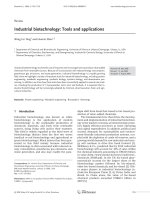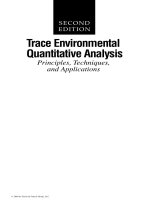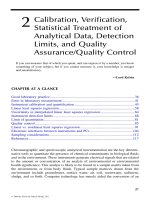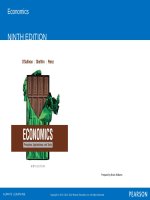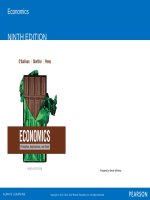Economics principles tools and applications 9th by sullivan sheffrin perez chapter 21
Bạn đang xem bản rút gọn của tài liệu. Xem và tải ngay bản đầy đủ của tài liệu tại đây (967.5 KB, 30 trang )
Economics
NINTH EDITION
Chapter 21
Insert Cover Picture
Market Efficiency and
Government
Intervention
Copyright © 2015, 2012, 2009 Pearson Education, Inc. All Rights Reserved
Learning Objectives
•
21.1 Use demand and supply curves to compute the value of markets
•
21.2 Explain why the market equilibrium maximizes the value of a market
•
21.3 Describe the market effects of price controls
•
21.4 Describe the market effects of quantity controls
•
21.5 Explain how a tax is shifted to consumers and input suppliers
Copyright © 2015, 2012, 2009 Pearson Education, Inc. All Rights Reserved
Market Efficiency and
Government Intervention
Efficiency
A situation in which people do the best they can, given their limited resources.
PRINCIPLE OF VOLUNTARY EXCHANGE
A voluntary exchange between two people makes both people better off.
A market equilibrium will generate the largest possible surplus when four conditions are met:
No external benefits: The benefits of a product (a good or service) are confined to the person who pays for it.
No external costs: The cost of producing a product is confined to the person who sells it.
Perfect information: Buyers and sellers know enough about the product to make informed decisions about whether to buy or sell it.
Perfect competition: Each firm produces such a small quantity that the firm cannot affect the price.
Copyright © 2015, 2012, 2009 Pearson Education, Inc. All Rights Reserved
21.1 CONSUMER SURPLUS AND
PRODUCER SURPLUS (1 of 4)
The Demand Curve and Consumer Surplus
●
Willingness to pay
The maximum amount a consumer is willing to pay for a product.
●
Consumer surplus
The amount a consumer is willing to pay for a product minus the price the consumer actually pays.
Copyright © 2015, 2012, 2009 Pearson Education, Inc. All Rights Reserved
21.1 CONSUMER SURPLUS AND
PRODUCER SURPLUS (2 of 4)
The Demand Curve and Consumer Surplus
Consumer surplus equals the maximum
amount a consumer is willing to pay (shown
by the demand curve) minus the price paid.
Juan is willing to pay $22, so if the price is
$10, his consumer surplus is $12. The
market consumer surplus equals the sum
of the surpluses earned by all consumers
in the market. In this case, the market
consumer surplus is $30 = $12 + $9 + $6
+ $3 + $0.
Copyright © 2015, 2012, 2009 Pearson Education, Inc. All Rights Reserved
21.1 CONSUMER SURPLUS AND
PRODUCER SURPLUS (3 of 4)
The Supply Curve and Producer Surplus
●
Willingness to accept
The minimum amount a producer is willing to accept as payment for a product; equal to the marginal cost of production.
●
Producer surplus
The price a producer receives for a product minus the marginal cost of production.
Copyright © 2015, 2012, 2009 Pearson Education, Inc. All Rights Reserved
21.1 CONSUMER SURPLUS AND
PRODUCER SURPLUS (4 of 4)
The Supply Curve and Producer Surplus
Producer surplus equals the market
price minus the producer’s willingness
to accept, or marginal cost (shown by
the supply curve).
Abe’s marginal cost is $2, so if the price
is $10, his producer surplus is $8. The
market producer surplus equals the sum
of the surpluses earned by all producers
in the market. In this case, the market
producer surplus is $20 = $8 + $6 + $4
+ $2 + $0.
Copyright © 2015, 2012, 2009 Pearson Education, Inc. All Rights Reserved
APPLICATION 1
COMPUTER SURPLUS OF INTERNET SERVICES
APPLYING THE CONCEPTS #1: How do we compute consumer surplus?
What is the consumer surplus from Internet service? Two recent studies compute consumers’ willingness to pay for Internet service. For Japanese consumers,
the average willingness to pay for Internet service (email and web browsing delivered over personal computers) is 5,623 Yen per month, compared to an
average price of broadband Internet service of 4,000 Yen.
In other words, the average consumer surplus is $1,623, or about 40 percent of the price.
For US consumers, the average willingness to pay for Internet service is $85 per month, and with an average monthly price of $40, the consumer surplus is $45
per month.
Copyright © 2015, 2012, 2009 Pearson Education, Inc. All Rights Reserved
21.2 MARKET EQUILIBRIUM AND EFFICIENCY (1 of 4)
● Total surplus
The sum of consumer surplus and producer surplus.
The total surplus of the market equals
consumer surplus (the lightly shaded
areas) plus producer surplus (the
darkly shaded areas).
The market equilibrium generates the
highest possible total market value,
equal to $50 = $30 (consumer surplus)
+ $20 (producer surplus).
Copyright © 2015, 2012, 2009 Pearson Education, Inc. All Rights Reserved
21.2 MARKET EQUILIBRIUM AND EFFICIENCY (2 of 4)
Total Surplus Is Lower with a Price below the Equilibrium Price
●
Price ceiling
A maximum price set by the government.
Total Surplus Is Lower with a Price above the Equilibrium Price
●
Price floor
A minimum price set by the government.
Copyright © 2015, 2012, 2009 Pearson Education, Inc. All Rights Reserved
21.2 MARKET EQUILIBRIUM AND EFFICIENCY (3 of 4)
Total Surplus Is Lower with a
Price above the Equilibrium Price
(A) A maximum price of $4 reduces the total surplus of the market. The first
two consumers gain at the expense of the first two producers. The consumer
and producer surpluses for the third and fourth lawns are lost entirely, so the
total value of the market decreases.
(B) A minimum price of $19 reduces the total surplus of the market. The first
two producers gain at the expense of the first two consumers. The consumer
and producer surpluses for the third and fourth lawns are lost entirely, so the
total value of the market decreases.
Copyright © 2015, 2012, 2009 Pearson Education, Inc. All Rights Reserved
21.2 MARKET EQUILIBRIUM AND EFFICIENCY (4 of 4)
Efficiency and the Invisible Hand
The market equilibrium maximizes the total surplus of the market because it guarantees that all mutually beneficial transactions will happen.
Instead of using a bureaucrat to coordinate the actions of everyone in the market, we can rely on the actions of individual consumers and individual producers,
each guided only by self-interest. This is Adam Smith’s invisible hand in action.
Government Intervention in Efficient Markets
In most modern economies, governments take an active role.
For a market that meets the four efficiency conditions, the market equilibrium generates the largest possible total surplus, so government intervention can only
decrease the surplus and cause inefficiency.
Copyright © 2015, 2012, 2009 Pearson Education, Inc. All Rights Reserved
APPLICATION 2
RENT CONTROL AND MISMATCHES
APPLYING THE CONCEPTS #2: Why does the market equilibrium maximize the value of a market?
Under rent control, the government sets a maximum price for housing, decreasing the quantity supplied and the total value of the market. Rent control and other maximum prices
cause inefficiency of another sort.
Consider a consumer living in a rent-controlled apartment who experiences a change in circumstances that would normally cause the consumer to a move to a different
apartment. For example, when a single person renting a tiny apartment gets married, he or she is likely to move to a larger place. But a consumer in a rent-controlled apartment
may stay in the tiny but inexpensive apartment, generating a housing mismatch. A recent study suggests that in New York City, about 20 percent of rent-controlled apartments are
mismatched.
The most famous case of a mismatched tenant is former Mayor Koch of New York. When he was elected mayor and moved into the mayor’s official residence, he held onto his
rent-controlled apartment, presumably anticipating his post-mayor life in an apartment at a controlled rent that was roughly one-third the market rent.
Copyright © 2015, 2012, 2009 Pearson Education, Inc. All Rights Reserved
21.3 CONTROLLING PRICES—
MAXIMUM AND MINIMUM PRICES (1 of 4)
Setting Maximum Prices
Here are some examples of goods that have been subject to maximum prices or may be subject to maximum prices in the near future:
•
Rental housing.
•
Gasoline.
•
Medical goods and services.
In all three cases, a maximum price will cause excess demand and reduce the total surplus of the market.
Copyright © 2015, 2012, 2009 Pearson Education, Inc. All Rights Reserved
21.3 CONTROLLING PRICES—
MAXIMUM AND MINIMUM PRICES (2 of 4)
Rent Control
(A) In the market equilibrium, with a price of $400 and 1,000 apartments, the
total surplus is the area between the demand curve and the supply curve.
(B) Rent control, with a maximum price of $300, reduces the quantity to 700
apartments and decreases the total surplus.
●
Deadweight loss
The decrease in the total surplus of the market that results from a policy such as
rent control.
Copyright © 2015, 2012, 2009 Pearson Education, Inc. All Rights Reserved
21.3 CONTROLLING PRICES—
MAXIMUM AND MINIMUM PRICES (3 of 4)
Rent Control
PRINCIPLE OF VOLUNTARY EXCHANGE
A voluntary exchange between two people makes both people better off.
Because rent control outlaws transactions that would make both parties better off, it causes inefficiency.
Three more subtle effects associated with rent control add to its inefficiency:
•
Search costs.
•
Cheating.
• Decrease in quality of housing.
Copyright © 2015, 2012, 2009 Pearson Education, Inc. All Rights Reserved
APPLICATION 3
PRICE CONTROLS AND THE SHRINKING CANDY BAR
APPLYING THE CONCEPTS #3: How Do Price Controls Affect the Market?
•
During World War II, the U.S. government used a system of price controls to set maximum prices on all sorts of products, including candy bars.
Consumer Reports compared the weights of candy bars in 1943 to their weights in 1939, before the maximum prices were imposed. In 19 of 20 cases, the
candy bars had shrunk, causing the price per ounce to increase by an average of 23 percent.
•
In other words, producers reacted to maximum prices by shrinking candy bars to match the relatively low maximum price. In the words of Consumer
Reports, the shrinkage of candy bars is an example of “hidden price increases.”
Copyright © 2015, 2012, 2009 Pearson Education, Inc. All Rights Reserved
21.3 CONTROLLING PRICES—
MAXIMUM AND MINIMUM PRICES (4 of 4)
Setting Minimum Prices
Recall that when government sets a minimum price above the equilibrium price, the result is permanent excess supply.
Governments around the world establish minimum prices for agricultural goods.
Under a price-support program, a government sets a minimum price for an agricultural product and then buys any resulting surpluses at
that price.
Copyright © 2015, 2012, 2009 Pearson Education, Inc. All Rights Reserved
21.4 CONTROLLING QUANTITIES—LICENSING AND IMPORT RESTRICTIONS
Taxi Medallions
(A) In the market equilibrium, with a price of $400 and 1,000 apartments,
the total surplus is the area between the demand curve and the supply
curve.
(B) Rent control, with a maximum price of $300, reduces the quantity to
700 apartments and decreases the total surplus.
The producers of the first 8,000 miles gain at the expense of
consumers, but the surpluses for between 8,000 and 10,000 miles are
lost entirely. Therefore, the total surplus decreases.
Copyright © 2015, 2012, 2009 Pearson Education, Inc. All Rights Reserved
(1 of 3)
21.4 CONTROLLING QUANTITIES—LICENSING AND IMPORT RESTRICTIONS
Licensing and Market Efficiency
Our analysis of taxi medallions applies to any market subject to quantity controls.
In general, a policy that limits entry into a market
▪ increases price,
▪ decreases quantity, and
▪ causes inefficiency in the market.
In evaluating such a policy, we must compare the possible benefits from controlling nuisances to the losses of consumer and producer surplus.
Winners and Losers from Licensing
Who benefits and who loses from licensing programs such as a taxi medallion policy?
The losers are consumers, who pay more for taxi rides.
The winners are the people who receive a free medallion and the right to charge an artificially high price for taxi service.
Copyright © 2015, 2012, 2009 Pearson Education, Inc. All Rights Reserved
(2 of 3)
21.4 CONTROLLING QUANTITIES—LICENSING AND IMPORT RESTRICTIONS
Import Restrictions
(A) With free trade, the demand intersects the total supply curve at point a with a
price of $0.12 and a quantity of 360 million pounds. This price is below the minimum
price of domestic suppliers ($0.26, as shown by point m), so domestic firms do not
participate in the market. The total surplus is shown by the shaded areas (U.S.
consumer surplus and foreign producer surplus).
(B) If sugar imports are banned, the equilibrium is shown by the intersection of the
demand curve and the domestic (U.S.) supply curve (point b). The price increases to
$0.30. Although the ban generates a producer surplus for domestic producers, their
gain is less than the loss of domestic consumers.
Copyright © 2015, 2012, 2009 Pearson Education, Inc. All Rights Reserved
(3 of 3)
APPLICATION 4
THE COST OF PROTECTING A LUMBER JOB
APPLYING THE CONCEPTS #4: What Are The Effects of Import Restrictions?
•
What is the cost of using import restrictions to protect jobs in the softwood lumber industry? Softwood lumber is subject to import quotas (quantity
restrictions) and tariffs (import taxes) that decrease the supply of lumber and increase the price to builders.
These policies protect about 600 jobs in the industry and impose a cost on consumers of roughly $632 million, so the cost per protected job is roughly $1 million
a year.
•
A recent study estimates the consumer benefits of relaxing import restrictions. The annual benefit would be $1.5 billion for ethanol, $49 million for sugar,
$514 million for textiles, and $215 million for footwear.
Copyright © 2015, 2012, 2009 Pearson Education, Inc. All Rights Reserved
21.5 WHO REALLY PAYS TAXES? (1 of 6)
Tax Shifting: Forward and
Backward
A tax of $100 per apartment shifts the supply curve upward by the $100 tax,
moving the market equilibrium from point a to point b.
The equilibrium price increases from $300 to $360, and the equilibrium
quantity decreases from 900 to 750 apartments.
Copyright © 2015, 2012, 2009 Pearson Education, Inc. All Rights Reserved
21.5 WHO REALLY PAYS TAXES? (2 of 6)
Tax Shifting and the Price
Elasticity of Demand
If demand is inelastic (Panel A), a tax
will increase the market price by a large
amount, so consumers will bear a large
share of the tax.
If demand is elastic (Panel B), the
price will increase by a small amount
and consumers will bear a small share
of the tax.
Copyright © 2015, 2012, 2009 Pearson Education, Inc. All Rights Reserved
21.5 WHO REALLY PAYS TAXES? (3 of 6)
Cigarette Taxes and Tobacco Land
In 1994, President Clinton proposed an immediate $0.75 per pack increase in the cigarette tax.
•
The tax had two purposes:
▪ Generate revenue for Clinton’s health-care reform plan
▪ Decrease medical costs by discouraging smoking.
Based on our discussion of the market effects of a tax, we would predict that the tax would be shared by consumers, who would pay higher prices, and the
owners of land where tobacco is grown.
It appears tobacco farmers and landowners understand the economics of cigarette taxes. Led by a group of representatives and senators from tobacco-growing
areas in North Carolina, Kentucky, and Virginia, Congress scaled back Clinton’s proposed tax hike from $0.75 to $0.05. Although the government would
have collected the tax from cigarette manufacturers, savvy tobacco farmers realized the tax would decrease the price of their tobacco-growing land.
Copyright © 2015, 2012, 2009 Pearson Education, Inc. All Rights Reserved
